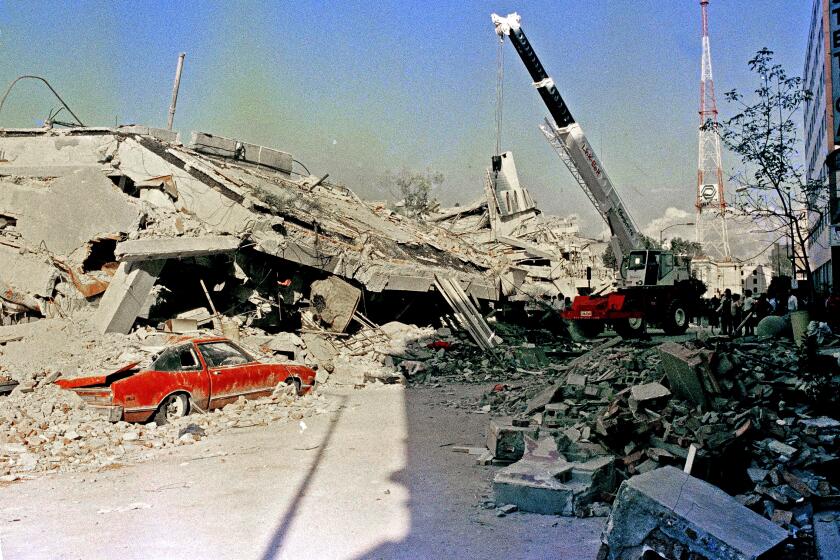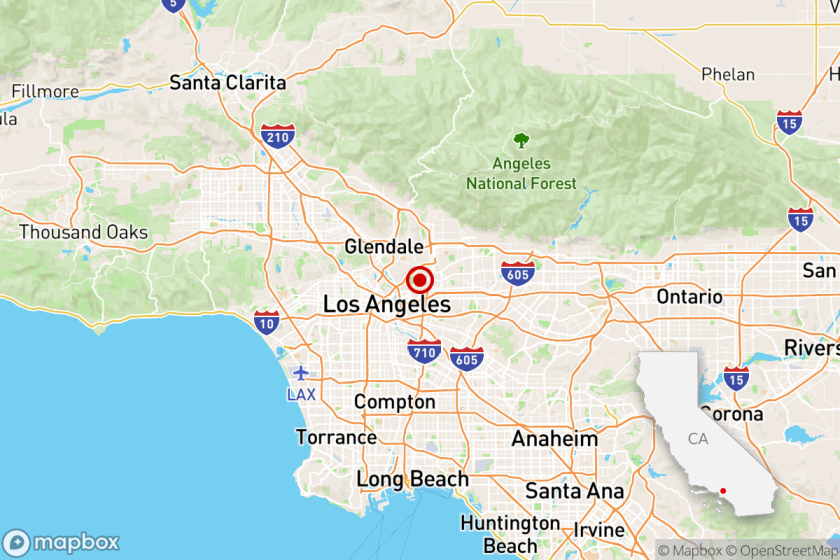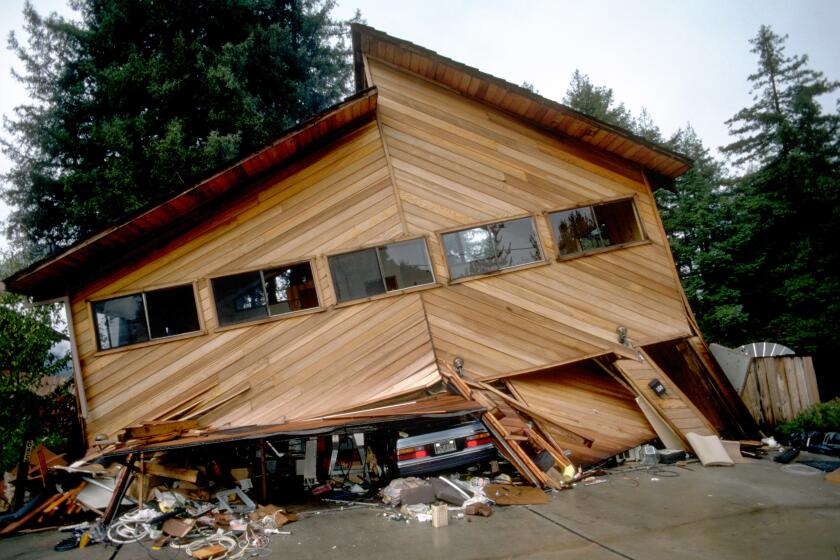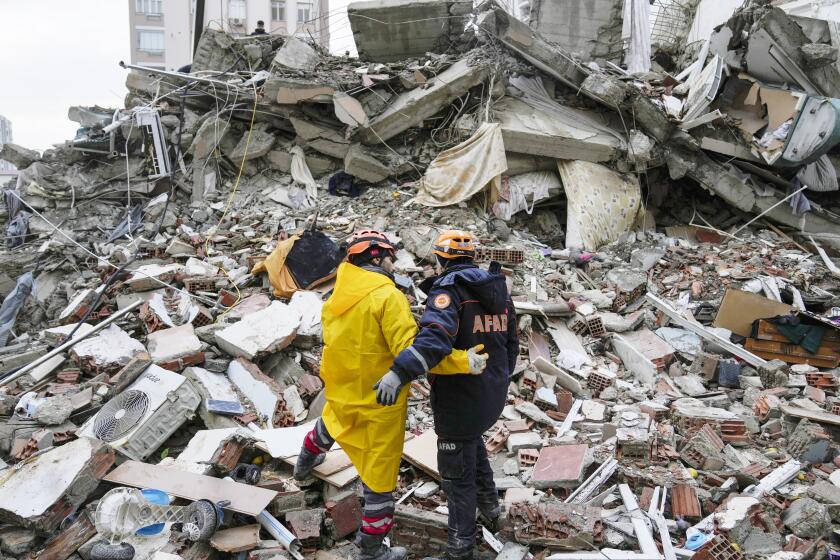Faster alerts for California megaquakes: Early-warning system gets major upgrade
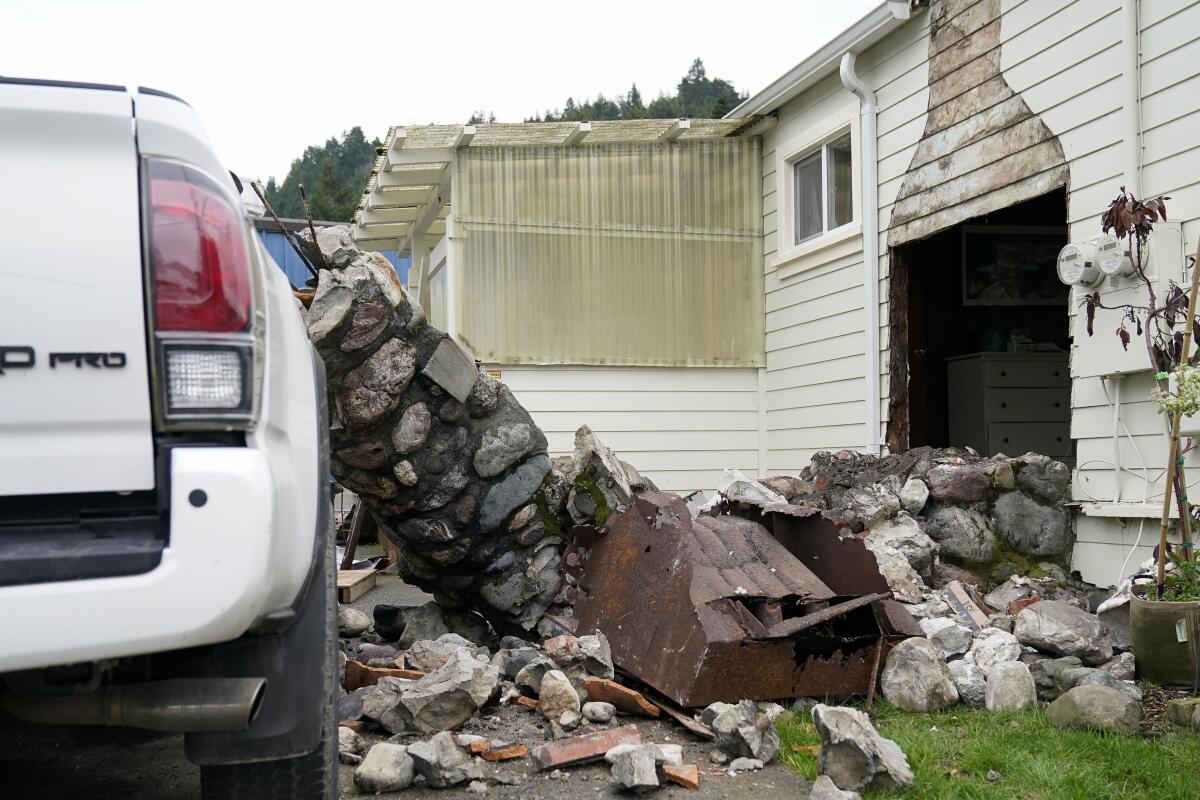
- Share via
California’s earthquake early-warning system is getting a seismic upgrade, one that will allow residents to receive more timely alerts about shaking from an incoming megaquake.
The upgrade, also available in Oregon and Washington, will provide features important for warnings about the “Big One.”
The improvements could mean that, depending on where they are and where the quake begins, Californians would receive an earlier, more accurate estimate of magnitude before the earth starts shaking — say from a magnitude 7.8 earthquake that begins on the San Andreas fault near the Mexican border and ruptures the fault toward Los Angeles County.
The upgrade also would improve warnings for the Pacific Northwest and California’s North Coast, which are threatened by tsunamis from quakes along the Cascadia subduction zone.
The U.S. Geological Survey and its nonprofit partner EarthScope announced the upgraded system Wednesday.
Japan has a sophisticated system to alert its residents, and Mexico City has ubiquitous sirens. Is California’s early warning system ready?
For the most powerful earthquakes, the improvements “become very, very critical in helping us get to the answer quicker — in terms of how big that event is,” said Robert de Groot, one of the operations team leaders of the USGS’ ShakeAlert System.
For smaller earthquakes, the older system worked “perfectly fine,” De Groot said. But with larger quakes, the magnitude could be underestimated for quite some time, robbing residents of crucial information in the seconds before they feel the most destructive shaking.
Let’s say an earthquake on the southern San Andreas fault that starts near the Mexican border ends up being a magnitude 8, but the earliest estimate says it’s a magnitude 6.5. The longer that underestimate is broadcasting to phones, the less likely people are to take appropriate action.
“People would react differently — much differently — than if you said it was a magnitude 8,” said David Mencin, vice president of data services for EarthScope, a nonprofit funded by the National Science Foundation, USGS and NASA that’s supplying data for the improved early-warning system.
The earthquake occurred near the Raymond fault, which runs from northeast L.A. through the foothills of the San Gabriel Valley.
“The largest, most destructive earthquakes are the ones that we’re really worried about,” Mencin said. “This fixes the problem of underestimating those magnitudes, which is critical.”
One of the most famous underestimations came in 2011 with the epic magnitude 9.1 earthquake that triggered a devastating tsunami off the eastern coast of Japan, leaving roughly 18,000 dead. An initial estimate put the quake’s magnitude at 7.9, meaning the actual earthquake was an astonishing 63 times stronger in terms of energy released.
The 7.4-magnitude earthquake that struck Taiwan on Wednesday can provide vital lessons for Southern California as it prepares for the next big temblor.
That underestimation led to a misjudgment of tsunami heights — with some of the first detailed alerts erroneously estimating the tsunami would be lower than protective sea walls. And when communications were cut off, a false sense of security settled in, with many people never receiving accurate evacuation alerts.
Had Japan used GPS data, a more accurate magnitude of the quake could’ve been generated far more quickly, Mencin said.
The USGS’ West Coast earthquake early-warning system has long relied on hundreds of seismic sensors embedded in the ground. But there is only so much shaking they can detect in a short time.
“Seismometers tend to get overwhelmed for earthquakes that are magnitude 7 and greater. They can begin to get ‘saturated,’” Mencin said. During particularly intense shaking, the seismometers — basically objects on a spring — start to hit the wall of the instrument, and so the seismic signal is “clipped” and can’t quickly calculate magnitudes above a certain threshold.
Coming to the rescue now are hundreds of GPS sensors on Earth’s surface and run by EarthScope. Most of the time, these sensors track very slow movement, on the order of millimeters or less per year. That can illustrate subtle tectonic plate action between major earthquakes, illustrating how the Pacific plate, where L.A. is located, is nudging northwest relative to the North American plate, where the Mojave Desert is located.
The defect that can cause single-family houses to collapse has received little attention until now. Some California homeowners will soon be able to apply for grants to help pay for the retrofit.
But in a major earthquake, there is considerable, permanent movement of the ground, where one piece of land jolts away from the other, moving yards in seconds. In the great San Francisco earthquake of 1906, land on one side of the San Andreas fault generally jammed 8.5 feet past the other, De Groot said.
And in the last great southern San Andreas earthquake — rupturing the fault in 1857 between Monterey and San Bernardino counties — land on one side of the fault generally lurched 10 feet relative to the other side. Both the 1857 and 1906 earthquakes were somewhere around magnitude 7.8.
In the largest of the Ridgecrest earthquakes in 2019, there were about 2 feet of fault offset for the magnitude 7.1 quake, De Groot said.
Earthquakes are a way of life if you live in Los Angeles. But what about when you never feel them — even as your Shake Alert is blaring and your friends are buzzing about the temblor?
The first calculation of the earthquake early-warning system will still rely on seismic sensors, which measure ground velocity and acceleration, De Groot said. Then, as a quake continues to rupture along a fault, GPS sensors will measure the distance a block of land has moved.
“What GPS allows us to do is to get a handle on how big that earthquake is getting — or could be — sooner,” De Groot said. That means the early-warning system could realize a quake was a magnitude 7, or higher, a few seconds earlier than before.
The San Andreas fault is capable of magnitude 7.8 earthquakes. Two have occurred twice in recent times: the 1906 San Francisco earthquake and one in 1857 in Southern California.
It’s important to know that an earthquake’s magnitude doesn’t appear instantly. Quakes rupture on a fault at the speed of sound through rock, which is slower than the light speed of today’s telecommunications systems. This is the principle that allows people farther away from the start of an earthquake to get seconds of advance warning of the worst shaking to come.
On the San Andreas fault, an earthquake that begins rupturing at the Salton Sea and ends at Mt. San Gorgonio, roughly 80 miles away, would produce a magnitude 7.3 earthquake.
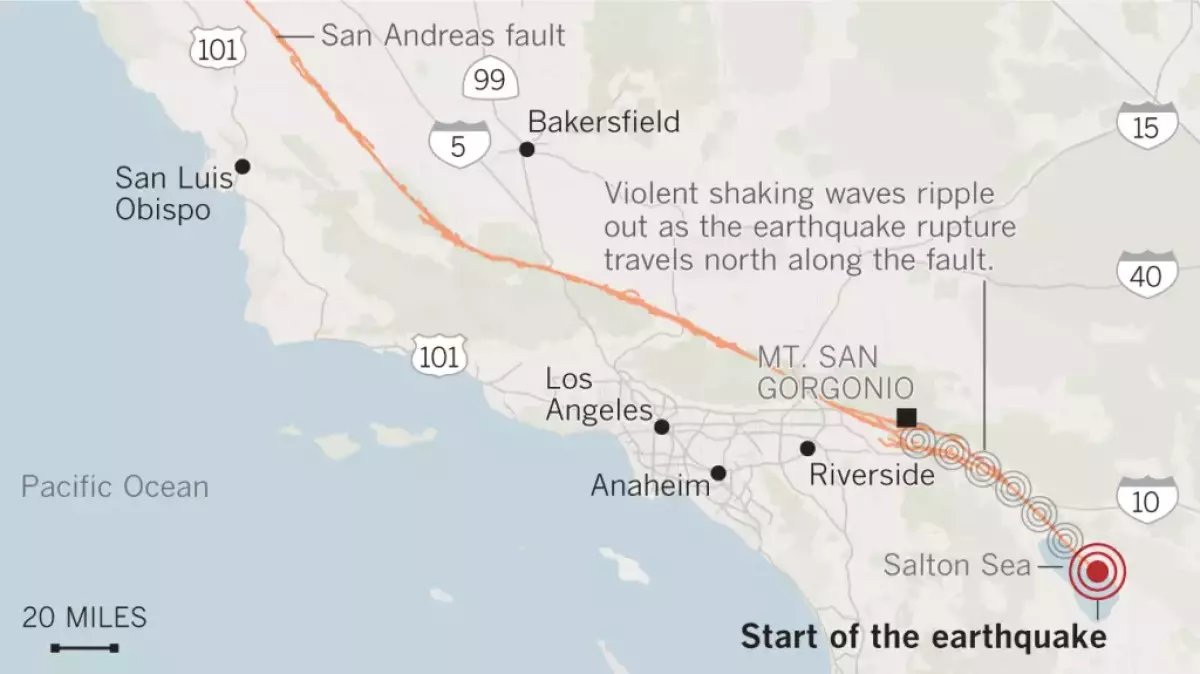
But one that ruptures the entire 340-mile length of the southern San Andreas, ending in Monterey County, would create a magnitude 8.2 earthquake and produce shaking over a much wider swath of Southern and Central California.
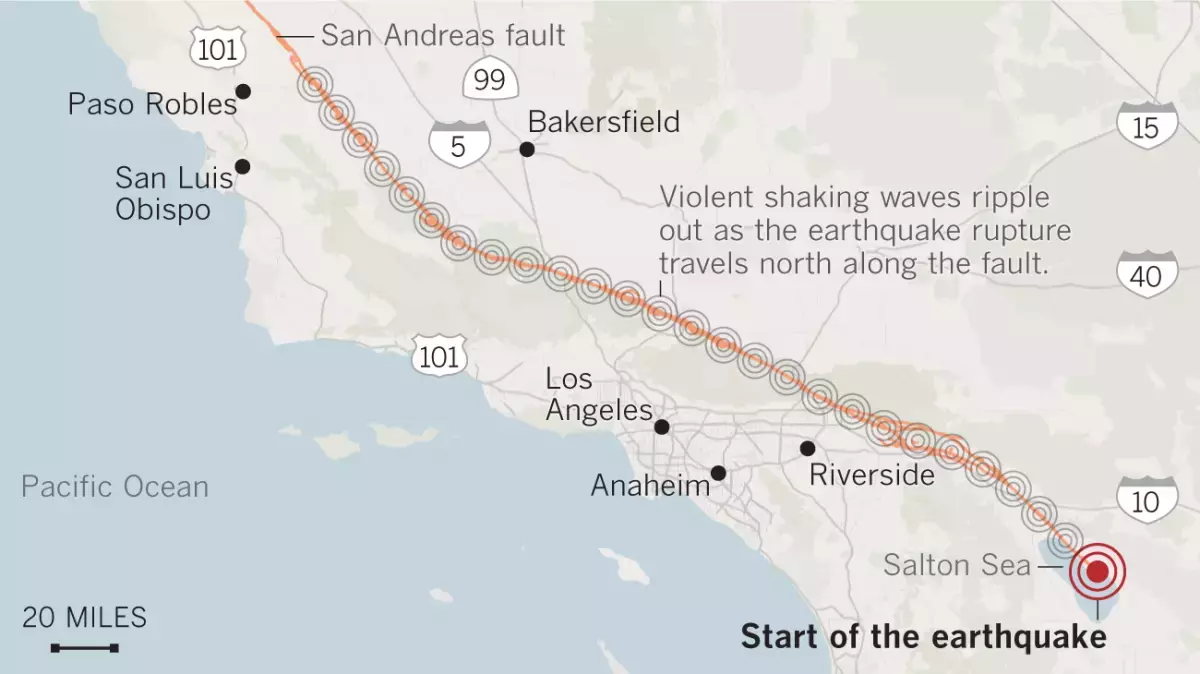
“As the earthquake grows in size, it’ll be able to help update that magnitude more quickly and with more accuracy,” De Groot said of the GPS data, which will spread the early warnings to a larger region. “By adding in the [GPS] data, you actually get a handle on how big the earthquake really is sooner.”
The net result will “translate into longer warning times for people who could potentially get alerts on their phones,” De Groot said. That would give people more time to take action, such as surgeons and dentists moving sharp tools from near patients, allowing trains to slow to reduce the risk of derailment, opening firehouse doors before they can be jammed shut and giving the public time to drop, cover and hold on.
Depending on where people are, some may not get a warning before they feel the first shaking, which is known as the “P wave.” But the goal is to give a warning before the most damaging shaking occurs — the “S wave” — which comes later.
“What we really want to get people to know about is getting the alert before the strongest shaking,” De Groot said.
By the end of 2025, the USGS’ ShakeAlert — which is about 90% complete — is expected to have 1,675 seismic sensing stations. EarthScope says an additional 1,000 GPS stations run by the nonprofit are contributing data to the system.
EarthScope, the nation’s primary seismological and geodetic data facility, was recently formed as the merger of UNAVCO, which held an archive for GPS data, and IRIS, which held a seismic data archive.
The earthquake early-warning system has become more popular in recent years as people get more accustomed to the alerts. In February’s widely felt magnitude-4.6 earthquake in Malibu, some felt left out when they didn’t receive an early warning.
The guide to earthquake readiness and resilience that you’ll actually use.
The alerts can be received by downloading the free MyShake app on iOS and Android. Android users are automatically subscribed to Android Earthquake Alerts. Those systems are set to sound an alarm when an earthquake is estimated to be of magnitude 4.5 or higher and the expected shaking intensity at the user’s cellphone location is expected to be at least “weak” — level 3 on the Modified Mercalli Intensity Scale, where it’s felt quite noticeably by people indoors and may rock standing motor vehicles slightly or feel like a truck is passing by.
Earthquakes of greater strength — magnitude 5 and above — will send users a wireless emergency alert, similar to an Amber Alert, if they’re in a location expected to get at least “light” shaking intensity. That’s level 4 on the Modified Mercalli Intensity Scale — shaking intensity enough to rattle dishes, windows and doors, and can feel like a heavy truck striking a building.
More to Read
Sign up for Essential California
The most important California stories and recommendations in your inbox every morning.
You may occasionally receive promotional content from the Los Angeles Times.
